Schools usually block access to certain websites because they want to discourage their students from illegally downloading content, accessing mature or explicit material or they sometimes just want to stop students from getting distracted or wasting time on social media sites.
A common way to get around this is by using a virtual private network (VPN).
But schools often block those too.
In this article, we’ll be looking at how and why schools block VPNs, how you can get your VPN to work at school, and how you can access blocked sites without a VPN.
Table of Contents
Why Is My VPN Not Working At School?

Your VPN is not working at school because your school’s network administrator or internet service provider (ISP) has disabled the communication ports it runs on or has blocked the IP addresses that your VPN is associated with.
When connecting to school WiFi – under normal circumstances – all of your online activity is logged and any websites that your school does not want you to access are automatically blocked.
Usually, if a student is able to connect to school WiFi using a VPN, websites that display explicit or illegal material would no longer be blocked.
Your school doesn’t want you connecting to their network via a VPN because it will bypass these blocking measures and make it possible for children or students to access mature or illegal content or waste time on social media.
How To Fix Your VPN Not Working At School?
At schools, VPNs are typically blocked via a TCP port number or by the VPN service’s IP addresses.
Try Different IP Addresses
The first thing to do if your VPN is blocked at school is to check with your VPN provider to see if they provide alternative IP addresses to connect to.
Connecting to your VPN over school Wi-Fi using a different IP address may be a quick way to get around your school’s block on VPNs.
Try A Different TCP Port
If you don’t have any luck trying different IP addresses, try connecting your VPN through a different TCP port.
HTTPS traffic is usually routed through TCP port 443 and this port is often not blocked.
Try using this port to connect to your VPN and it may work.
If you find and your school is also blocking VPNs through this port, you can try using SSTP.
This will use the same port but it will encrypt the data and may allow you to connect to your VPN.
If your SSTP connection is detected and blocked by the school try disconnecting and reconnecting to re-establish the VPN session.
You can also try connecting through port 443 using SoftEther, providing your VPN supports it.
Try Different VPNs
Your school may not have blocked every single VPN provider out there, especially newer and less well-known ones.
You could try to find a different VPN service that is not blocked by your school.
Just use free trials of as many VPNs as you can find until you find one that works.
How Can The School Tell If I’m Using A VPN
A VPN connection will tunnel all of your network traffic once it reaches it.
But for your traffic to reach your VPN it first has to travel over the school’s network.
This means that your school will be able to see the data packets traveling along on their network before they reach your VPN server.
They will be able to see and identify you by your MAC address and they will be able to see your traffic going to your VPN server’s IP address.
A network administrator will be able to tell that you are connecting to a virtual private network.
However, the information being transmitted through your VPN’s secure tunnel will be encrypted, so they won’t be able to see the websites you are visiting once you have established a connection to your VPN.
You Might Also Like: Should I Use A VPN At A Hotel? (And How To Stay Safe)
Is Using A VPN At School Illegal?
Using a VPN is not illegal in the United States or most other countries, and the act of using a VPN at school is not specifically illegal.
So you would not be breaking the law by using a VPN at school but it would probably be against school policy and may land you in trouble.
Using a VPN at school will also make you more likely to break the law because you may inadvertently access illegal content that would otherwise have been blocked by the government or your school.
Can You Get In Trouble For Downloading A VPN On A School Computer?
If VPNs are banned at your school then you will most definitely get in trouble for downloading a VPN onto a school’s computer.
And the websites where VPNs are downloaded from will most likely be blocked by your school too.
However, there are some VPN services that allow you to get around this by providing you a link to their downloads via email.
For example, to download Psiphon VPN you would have to create a new email and enter “get@psiphon3.com” into the address bar.
Then input the name of your operating system into where the email subject goes and hit send.
They will then reply by email with a list of links for you to download the VPN (don’t forget to check the spam folder).
You can then download the VPN onto your school’s computer and rename that something less obvious.
What VPNs Work With School WiFi?
There’s really no telling which VPNs will work on your school’s network until you try some out.
Some schools only block IP addresses associated with popular VPNs while others try much harder to block all VPNs.
Here are a few to try out:
UFO VPN
UFO VPN is the self-proclaimed best VPN service to get around school Wi-Fi blocks.
They advertise themselves as being a super-fast VPN that can bypass school WiFi and open blocked websites, services, and applications.
You can also try using some lesser-known VPNs, like HideNinja, which many people find to work well at US schools.
And try out the more common ones like CyberGhost and Nord VPN.
Try out all of the different IP addresses that they offer to see if any of them will allow you to connect to your school network.
Are There Any Free VPNs That Work At School?
Just like with paid options, you won’t know if any free VPNs will work at your school either until you try them out.
Here are some quality-free ones to try out.
ProtonVPN
ProtonVPN is a Swiss-based VPN provider that offers both paid and free services, but their free service is enough to cover most needs.
ProtonVPN is great because it’s secure and fast and hales from privacy-friendly Switzerland, but the free service only allows one device to be connected at a time (paid versions allow 3+), so you can’t use your PC, phone, and tablet simultaneously with just the free version.
TunnelBear
You can use TunnelBear as a free VPN service if you can stay below a usage level of 500 MB per month.
It has excellent ratings for its iOS and Android apps with an average rating of 4.5 stars out of five.
Their software is really simple and shouldn’t be a problem for most people, even if they’ve never used a VPN before.
TunnelBear also has a paid service with more features and servers, but the free version will be enough for most people since it’s secure and fast.
Windscribe
Windscribe is a Canadian VPN provider that has recently made its way into people’s attention for the right reasons.
When you sign up with Windscribe, you’ll get a free account with 2GB worth of VPN bandwidth each month.
And If you confirm your email address with them, you’ll be upgraded automatically to the free 10GB monthly plan.
They also have servers in 10 countries around the world for free users and you can use unlimited devices simultaneously.
Is There Any Way To Bypass School WiFi Blocks Without A VPN?
When it comes to trying to bypass school Wi-Fi blocks there are other options available besides VPNs.
The Tor Browser
Tor, also known as The Onion Router, basically makes you go through a lot of different proxies before reaching the website you want to connect to while hiding your internet activities from whoever is trying to monitor what you’re doing.
Downloading and using Tor is pretty straightforward.
First, you’ll have to download and install the Tor Browser onto your device (most are supported).
You can then launch the browser, adjust privacy and security settings and begin browsing.
Access Blocked Websites At School Using Short Links
This is a popular method because it often works and is very easy to try out.
Using shortened URLs may fool your school into granting you access to sites that would otherwise have been blocked.
It’s really easy to try out.
Simply copy the full URL of the website you want to visit into a URL shortening service like Bitly or TinyURL and it will give you a shortened version of the full URL that may fool your school’s block on that website.
Just paste the shortened URL into the address bar of your browser and hit Enter to see if it works.
Access Blocked Websites At School Using An IP Address
Similar to the shortened links method, the full website URL might be blocked, but the site’s IP addresses may not be.
To try this out search for “Command Prompt” in the windows search bar.
Type “tracert” and the domain of the website that is blocked and hit enter.
It should display the IP address of the website you are trying to access.
Copy the IP address into the web browser and hit search to see if it will allow you access to the site.
Using A Web Proxy
There are loads of free web proxies that will allow you to browse the web anonymously.
Just search for “proxy sites” in Google and you’ll find a ton of them.
All you have to do is visit a site like KProxy and enter the URL of the blocked site you want to browse.
Final Thoughts
So, now you have a good idea of why your VPN isn’t working at school.
Keep in mind that this article is not intended to be exhaustive or all-encompassing on the subject of VPNs and schools.
There are many other factors that may come into play when attempting to use a VPN at school, so if nothing here has helped you, keep researching.
There are loads of smart people out there who have found ways around their school’s VPN blocks.



